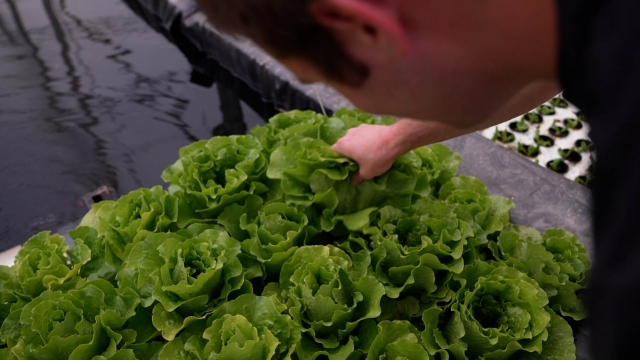Nearly 100% of the lettuce in the U.S. is produced in California and Arizona year-round, according to the Agriculture Marketing Resource Center.
However, the industry’s crops have taken a hit with hotter temperatures and crop diseases, causing a shortage and causing the price of lettuce to rise.
"Centralization of the lettuce industry means any kind of impact, whether it's weather or any issue of crop management, it affects the entire country all at once," said Trevor Kenkel, founder of Springworks Farm.
But if you come to Lisbon, Maine, you'll find one of the biggest lettuce producers on the East Coast, run by Kenkel.
He showed us how the lettuce grows on a tray in a tank of water.
"They just grow on top of water, and the roots grow right into it," said Kenkel.
This is called aquaponics, an organic way to grow lettuce all by using a type of fish, a system designed by Kenkel.
"These guys have been here for a few weeks, and they will grow throughout the rest of the year and produce fertilizer the whole time," Kenkel said of the fish. "We combine fish and plants in a recirculating system where the fish provide fertilizer for plants."
Springworks raises the fish and uses their wastewater to fertilize the lettuce.
The plants clean the water, so it can then be recirculated, filtered, and sent back to the fish tanks, which allows Springworks to use less water than a conventional lettuce farm.
SEE MORE: Data shows more farmers are trading in tractors for drones
Using fewer resources and producing about 2 million heads of lettuce every year and up to 200,000 pounds of tilapia, this is a method that is currently untouched by climate change and crop diseases.
"We're one of the largest in the country, and only a handful use this technique right now, but it's a way of integrating sustainable protein production with sustainable plant production," said Kenkel. "We grow about 20 times more lettuce per acre than a conventional field."
Kenkel believes other communities can do this to help prevent shortages and provide jobs in places like California and Arizona, where climate change and diseases have made things more difficult.
"One of the key benefits here is that they didn't take an existing farm and grow it; they took land and turned it into these greenhouse spots they're producing on land that wasn't farmland before," said Ross Cunningham, economic community developer for the city of Lisbon. "They are providing jobs and creating produce locally, and it's just phenomenal, and as they continue to expand, we're really happy they are able to provide that type of economy for our citizens."
Springworks is expanding in Maine but hopes others across the country can adopt its approach to lettuce and fish farming to help provide more while using less.
"A regionalized approach allows for many things to happen," like conserving resources such as gasoline when products don't have to come all the way from California, said Sierra Kenkel, vice president of Springworks Farm. "Because if we can make systems like this so products are traveling only 250 miles, they're getting fresher product. It's a battle of waste, and the goal is to have zero waste."
Trending stories at Scrippsnews.com



